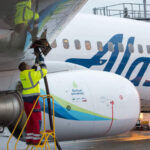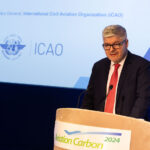The UK government has published its Jet Zero strategy to achieve a target of net zero aviation emissions by 2050. It expects UK emissions to have peaked in pre-pandemic 2019 at 38.2 million tonnes of CO2 equivalent (MtCO2e) and is setting a goal of reducing this to 19.3 MtCO2e in-sector emissions by 2050, with the remainder compensated through carbon markets and investments in greenhouse gas removal (GGR) technologies. The strategy also commits UK domestic aviation, which is responsible for 1.4 MtCO2e (4%) of total emissions annually, to achieving net zero by 2040 and for all airports in England to be zero-emission by the same year. The government believes sustainable aviation fuels are a key technology, particularly for long-haul flights, in reaching net zero and pledges to build “a thriving” UK SAF production industry, and will bring in a SAF mandate by 2025, when it expects at least five commercial-scale plants to be under construction in the UK that will help to ensure 10% SAF use (1.2 Mt) by 2030. Aviation fuel usage reached 12.4 Mt in 2019 and under its ‘high ambition’ scenario, 5 Mt of SAF are required by 2050 to meet net zero. The government also sees hydrogen as playing an important role in the development of future zero emission aircraft.
“We want 2019 to be remembered as the peak year for aviation emissions. From now on, it should all be downhill for carbon emissions and steadily uphill for green flights,” commented UK Transport Secretary Grant Shapps on the publication of the Jet Zero Strategy, released at the recent Farnborough Airshow.
Although acknowledging reaching net zero will be challenging and that aviation will be one of the UK’s largest residual emitting industries in 2050, the government believes the sector can reach the target without resorting to demand management to cap its growth. “Rather than clipping its wings, our pathway recognises that decarbonisation offers huge economic benefits, creating the jobs and industries of the future and making sure UK businesses are at the forefront of this green revolution,” said Shapps.
The foreword by transport ministers to the strategy document says by future-proofing aviation, “passengers can look forward to guilt-free travel. In doing so, our economy can reduce its dependence on dirty energy. We can unlock the benefits of green technology and the thousands of new skilled jobs that come with it. And aviation, often criticised for its contribution to climate breakdown, can safeguard its future through a more sustainable industrial model.”
The government sees six priority areas as part of the strategy, covering efficiency improvements in aircraft and airspace, increasing support for SAF, supporting the development of zero-emission aircraft, developing carbon markets and GGR technologies, providing consumers with better information so they can make sustainable aviation choices and increasing understanding of aviation’s non-CO2 impacts.
The strategy says aircraft fuel efficiency will be improved by 2% every year and the government is pledging a further £3.7 million (4.5m) will be provided in 2022 and 2023 to support airports in modernising their airspace. It will also support the domestic SAF industry and the commitment for five new commercial-scale SAF plants to be under construction by 2025, helped by a new £165 ($200m) million Advanced Fuels Fund. This will build on previous funding, such as the £15 million Green Fuels, Green Skies competition. The government has also announced a £1 million competition to deliver the first-ever net zero transatlantic flight powered by 100% SAF.
It is also supporting industrial R&D through the ATI Programme, with £685 million ($835m) funding over the next three years to support the development of zero-carbon and ultra-low emission aircraft technology, and has also invested £3 million in the Zero Emission Flight Infrastructure (ZEFI) project. The government has an aspiration to have zero emission routes connecting different parts of the UK by 2030. To help achieve the goal, it pledges to double UK ambition for hydrogen production to up to 10GW by 2030, with at least half of this from electrolytic hydrogen. Rapid investment in hydrogen aviation could see the UK, says the government, securing up to 19% of the global aerospace industry share, valued at £178 billion per year in 2050, and 60,000 aerospace jobs on zero-carbon aircraft by the same year.
Although the strategy focuses on reductions in CO2 emissions, the government recognises aviation’s additional climate warming impacts from contrail cirrus and other non-CO2 effects. However, it says, there are “large uncertainties” over the magnitude of these impacts – around eight times more uncertain than those resulting from CO2. Current research indicates SAF can produce 50%-70% fewer soot particles, which could reduce the overall warming effect of contrails, but, says the government, “we will carefully consider any need for additional research and development activity on non-CO2 effects, including working with UK Research and Innovation.” It adds that it is exploring whether and how non-CO2 impacts could be included in the scope of the UK ETS and aims to develop a methodology to monitor non-CO2 impacts “on a regular basis”.
As part of the strategy, the government wants consumers to have access to environmental information at the time of booking a flight and intends working with the CAA on a Call for Evidence to be published this coming autumn. It also wants consumers to have available sustainable modes of transport to and from airports in England.
On the controversial subject of UK airport expansion, the strategy document says: “We will support airport growth where it can be delivered within our environmental obligations. The aviation sector is important for the whole of the UK economy in terms of connectivity, direct economic activity, trade, investment and jobs. We are committed to enabling a green recovery of the sector, as well as sustainable growth in the coming years.
“The government’s existing planning policy frameworks, along with the Jet Zero Strategy and the Flightpath to the Future strategic framework for aviation, have full effect and are material considerations in the statutory planning process for proposed airport development.”
However, it adds: “It is vital that local communities and the wider public have confidence that the impacts of airport expansion have been properly considered.”
The Jet Zero Strategy, says the government, is underpinned by three guiding principles that will apply to all policy measures: providing international leadership, engaging in collaborative partnerships (such as the Jet Zero Council) and maximising the opportunities to create new jobs, industries and technologies. On the first, it intends to carry on its ongoing work at ICAO for member states to agree an ambitious long-term aspirational goal on emissions from international aviation and agree and support measures to meet the goal, including strengthening CORSIA and introducing a global SAF objective. It also expects to build on its collaboration with like-minded states – now numbering 34 in total – through the International Aviation Climate Ambition Coalition (IACAC) that was launched by the UK at COP26.
The government promises to review the strategy every five years and measure progress against its emissions reduction trajectory and key performance indicators that have been set out across each policy measure.
“This strategy provides the clear vision and leadership required to tackle one of the great industrial challenges of our time – decarbonisation of aviation,” commented UK Business Secretary Kwasi Kwarteng. “Importantly, it is also clear the global shift to cleaner forms of flight represents a huge opportunity to secure growth and jobs for the UK.
“Through the ambitious steps outlined in this strategy and close collaboration with our world-leading industrial and innovation base, the UK stands ready to capitalise on first mover status, seizing the economic benefits of a green aviation revolution.”
Welcoming the government’s net zero strategy, Emma Gilthorpe, CEO of the industry/government Jet Zero Council, said: “This is a key milestone on the path to decarbonising aviation, setting the framework for the Council to continue its great progress on sustainable aviation fuels and zero emission flight, and providing key policies to get us there, including a SAF mandate.
“I also welcome the ambitions for five SAF plants to be under construction by 2025 and zero-emission UK routes this decade, and look forward to working with the Council’s dedicated delivery groups to help achieve this.”
Photo: Heathrow Airport















More News & Features
UK government sets out new Jet Zero focus and launches consultation on CORSIA global emissions scheme
New study highlights differing strategies and barriers to decarbonising aviation in UK and Europe
ICAO signs agreement with IRENA to boost finance opportunities for SAF production
European aviation players launch Project SkyPower to drive investment in e-SAF and meet EU and UK mandates
Cambridge report sets four goals to be implemented by 2030 for global aviation to reach Net Zero
Novel catalyst pioneer OXCCU launches first-of-a-kind PtL SAF demonstration facility